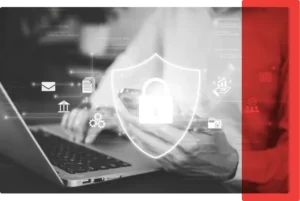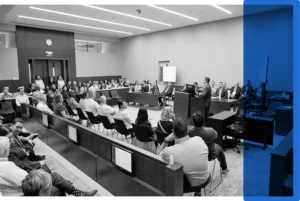
17 Oct
2023
Build It or Buy It? The best approach to legal technology in modern courtrooms
Somewhere in the world today, a court’s IT professionals, its clerks, its administration workers, and perhaps even its judges are asking themselves: “do we build, or do we buy?”
When it comes to software—particularly in such a nuanced and important environment as the courtroom—the question is not surprising. Getting reliable, fit-for-purpose products and technology solutions that serve the court’s needs not only requires high-level technical ability, but also a deep understanding of the court’s processes and traditions.
Resolving the “build or buy” question
In the mission-critical operations of the justice system, the answer is clearly “neither.” Courts that are today maximizing technology—and keeping pace with its rapid changes and improvements and seamlessly delivering the best justice outcomes possible—are those that rely on a blended model.
This refers to buying court-specific software and digital solutions that are then implemented collaboratively to integrate with—and enhance—the jurisdiction’s existing systems and processes.
Building—the pros and cons
The justice system is complex: lives depend on its reliability, precision, and transparency—and it operates within a highly specialized environment.
So, it’s reasonable for a court to want to create its own audio/video recording and storage system; its own transcript delivery and ordering processes; or its own remote or hybrid video-conferencing setup to name a few examples.
That’s the single greatest benefit of self-built software—total control of all features, including how they serve the court’s needs and how they integrate with existing software, processes, and platforms.
Unfortunately, the realities of creating a new solution from scratch are often underestimated. Some of the roadblocks to success are:
- Staffing considerations
You may have developers and designers who can start the build but it’s more likely you will need to hire skilled people with specific experience. In the US today, however, there is a shortage of skilled software developers and an increasing number of positions available. This growing demand means you’ll pay higher salaries to fill those positions.
Can you acquire, afford, and hold on to the talent you will need to not only build your software, but support it when things go wrong in the months and years to come?
- Funding
It’s crucial to consider the price of in-house development—the costs of creating new software can blow out very quickly. Is there room within the budget already, or do you need to secure funding from an external source? Will the funding be considered a capital expense or operational expense—or both?
Since capital expenses are investments made to improve your organization over time, while operational expenses are costs incurred to maintain operations, it can be difficult for courts to obtain funding due to the long-term nature of capital expenditure.
- Accountability
You’ll need a project manager to run the process—keeping track of team hours, duties, and deadlines.
Is there someone in your court experienced enough in project accountability? Can you afford to free them up to manage the build and liaise with all the creatives and court stakeholders? Or will you need to bring in, and pay, a new staff member specifically for the job?
- Support and updates
So, you’ve created your own software solution. But while you’ve been focused on the build, there have been dramatic technology breakthroughs. Your system may be too specifically customized to your environment, so your team is unable to update your product without significant effort.
For example, there’s a national court system that, in 2005, was ahead of the pack, commissioning its own digital recording software. Today, the jurisdiction is using a solution unchanged in more than 17 years. Due to a lack of scalability and flexibility within the original design, there have been minimal to no updates or improvements.
As a result, that jurisdiction’s courts are now struggling to deliver the best judicial outcomes with their outdated systems and processes.
What the data shows about software-build success
According to gold-standard global research, the odds of a commissioned software build coming in on time, on budget, or coming in at all are not good.
The CHAOS (Comprehensive Human Appraisal for Originating Software) Report—prepared regularly since 1995 by software industry research organization The Standish Group—originally found less than 16 percent of software projects were considered “successful”. The report noted when big companies undertook new software builds, less than half of the features required were ultimately delivered.
Those figures have improved marginally over the years, but the latest CHAOS report still reveals a dramatic new “red flag” for any organization considering building their own software solution: the entire concept of a “software project” is outdated.
Modern development dictates that once a solution is created, tested, and implemented, it must be constantly refined. That’s because the sheer speed of developments in technology mean that—when thinking of this revelation in terms of the justice system—only courts that are always updating to embrace and deploy ongoing technology improvements will be delivering best-practice justice.
CHAOS author Jim Johnson calls this process of continual reiteration “Infinite Flow.” For companies and businesses—or courts—that don’t specialize in software development, maintaining “Infinite Flow” into the future is especially difficult.
The pros and cons of buying off-the-shelf
Buying a ready-made software product is usually going to cost less, in the short term, than building your own. The trialing and testing has been done; bugs and issues have been ironed out; and the supplier will often charge a fixed price or license fee, protecting the buyer from the cost-blow outs that regularly plague self-builds.
However, ready-made solutions aren’t always ideally suited to a court’s specific environment or needs because they’re typically mass-produced with multiple end users in mind. Some products may have been adapted to meet high-level demands of courts but don’t necessarily consider the nuances of court environments.
For instance, off-the-shelf videoconferencing systems, which became more prevalent during the pandemic, were adapted to meet the demand for remote hearings.
Given the nature of adapted platforms, courts had to develop workarounds to ensure these platforms offered similar functionality previously seen within regular operations. So, the product’s usability may be limited or it may create new barriers for access to justice.
Additionally, companies offering off-the-shelf solutions tend to provide generalized support services without dedicated people who specifically understand your court’s environment and systems. When systems experience glitches or outages, the outcome may be extended downtime while you work to get the issue resolved.
As a result, a jurisdiction may need to create new processes; buy new platforms; spend excess time with generalized support teams; or adapt existing hardware and software to get the most out of its purchase—which all costs time and money.
Why blended is the answer
For justice technology vendors, the primary goal is to provide problem-solving solutions and services, not products that may require further workarounds to be successful.
To achieve this, For The Record partners with a jurisdiction. As experts in sound and sight technology, and with 30 years of deep understanding of court processes and traditions, For The Record comes to the partnership with rare knowledge and insight.
First, we collaborate to familiarize ourselves with your specific environment and processes to ensure we have a holistic view of your set-up and operations. We then offer solutions that have been tried and tested in courts around the world, providing the cost, reliability, specialized tech support, and security benefits that courts require.
It’s the equivalent of an off-the-shelf solution in the sense that they’re ready to deploy at any time, but we have foreseen the pitfalls that “buying blind” or managing in-house would have brought.
This occurs through effective integration with existing and new processes; ongoing servicing and dedicated support from industry experts; stringent security measures; and a feedback loop which ensures feature requests and updates from our clients are actioned or added to our development roadmap.
Not only does this approach answer the “build or buy” question, but it rules out the risks identified in the CHAOS report. By choosing to buy a solution coupled with the ongoing support and technology wisdom of For The Record, a court ensures its software solutions will be fit-for-purpose, reliable, and always up-to-date.
Get in touch to learn more about our approach to justice technology.



